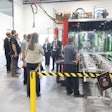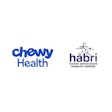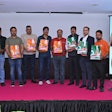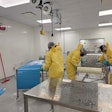Winpak reports consolidated results in US dollars for the fourth quarter of 2020, which ended on December 27, 2020.
|
Quarter Ended |
Year Ended |
||||||
|
December 27 |
December 29 |
December 27 |
December 29 |
||||
|
2020 |
2019 |
2020 |
2019 |
||||
|
(thousands of US dollars, except per share amounts) |
|||||||
|
Revenue |
212,091 |
217,456 |
852,493 |
873,843 |
|||
|
Net income |
28,077 |
27,521 |
108,915 |
118,064 |
|||
|
Income tax expense |
9,303 |
9,830 |
38,800 |
41,711 |
|||
|
Net finance expense (income) |
81 |
(996) |
(955) |
(4,801) |
|||
|
Depreciation and amortization |
11,458 |
12,640 |
44,767 |
43,570 |
|||
|
EBITDA (1) |
48,919 |
48,995 |
191,527 |
198,544 |
|||
|
Net income attributable to equity holders of the Company |
27,256 |
26,679 |
106,321 |
114,772 |
|||
|
Net income attributable to non-controlling interests |
821 |
842 |
2,594 |
3,292 |
|||
|
Net income |
28,077 |
27,521 |
108,915 |
118,064 |
|||
|
Basic and diluted earnings per share (cents) |
42 |
41 |
164 |
177 |
|||
Winpak Ltd. manufactures and distributes high-quality packaging materials and related packaging machines. The Company's products are used primarily for the packaging of perishable foods, beverages and in healthcare applications.
1 EBITDA is not a recognized measure under International Financial Reporting Standards (IFRS). Management believes that in addition to net income, this measure provides useful supplemental information to investors including an indication of cash available for distribution prior to debt service, capital expenditures, payment of lease liabilities and income taxes. Investors should be cautioned, however, that this measure should not be construed as an alternative to net income, determined in accordance with IFRS, as an indicator of the Company's performance. The Company's method of calculating this measure may differ from other companies and, accordingly, the results may not be comparable.
(presented in US dollars)
Forward-looking statements: Certain statements made in the following report contain forward-looking statements including, but not limited to, statements concerning possible or assumed future results of operations of the Company. Forward-looking statements represent the Company's intentions, plans, expectations and beliefs, and are not guarantees of future performance. Such forward-looking statements represent Winpak's current views based on information as at the date of this report. They involve risks, uncertainties and assumptions and the Company's actual results could differ, which in some cases may be material, from those anticipated in these forward-looking statements. Factors that could cause results to differ from those expected include, but are not limited to: the terms, availability and costs of acquiring raw materials and the ability to pass on price increases to customers; ability to negotiate contracts with new customers or renew existing customer contracts with less favorable terms; timely response to changes in customer product needs and market acceptance of our products; the potential loss of business or increased costs due to customer or vendor consolidation; competitive pressures, including new product development; industry capacity, and changes in competitors' pricing; ability to maintain or increase productivity levels; ability to contain or reduce costs; foreign currency exchange rate fluctuations; changes in governmental regulations, including environmental, health and safety; changes in Canadian and foreign income tax rates, income tax laws and regulations. In addition, factors arising as a result of the Coronavirus (COVID-19) global pandemic that could cause results to differ from those expected include, but are not limited to: potential government actions, changes in consumer behaviors and demand, changes in customer requirements, disruptions of the Company's suppliers and supply chain, availability of personnel and uncertainty about the extent and duration of the pandemic. Unless otherwise required by applicable securities law, Winpak disclaims any intention or obligation to publicly update or revise this information, whether as a result of new information, future events or otherwise. The Company cautions investors not to place undue reliance upon forward-looking statements.
Financial Performance
Net income attributable to equity holders of the Company for the fourth quarter of 2020 amounted to $27.3 million or 42 cents in earnings per share (EPS), surpassing the 2019 corresponding result of $26.7 million or 41 cents per share by 2.2 percent. Higher sales volumes raised EPS by 1.0 cent. The Company estimates that COVID-19 dampened this result by 0.5 cents. Gross profit margins led to a contraction in EPS of 2.0 cents. Foreign exchange, operating expenses and income taxes augmented EPS by 1.5 cents, 1.0 cent and 1.0 cent, respectively. Net finance expense (income) subtracted 1.5 cents from EPS.
For the year ended December 27, 2020, net income attributable to equity holders of the Company of $106.3 million or $1.64 per share, a decrease from the prior year's net income of $114.8 million or $1.77 per share by 7.4 percent. Overall, lower sales volumes caused EPS to decline by 4.0 cents. Of this amount, it is estimated that COVID-19 accounted for a decrease of 3.0 cents, whereas non-COVID-19 related sales shortfalls negatively affected EPS by 1.0 cent. Lower gross profit margins were a significant factor, adversely impacting EPS by 7.5 cents. The change in net finance expense (income) lowered EPS by an additional 4.0 cents. Operating expenses and net income attributable to non-controlling interests had a positive effect on EPS to the extent of 1.5 cents and 1.0 cent, respectively. Foreign exchange had a minor favorable influence on EPS of 0.5 cents but was nullified by higher income taxes.
Operating Segments and Product Groups
The Company provides three distinct types of packaging technologies: a) flexible packaging, b) rigid packaging and flexible lidding and c) packaging machinery. Each is deemed to be a separate operating segment.
The flexible packaging segment includes the modified atmosphere packaging, specialty films and biaxially oriented nylon product groups. Modified atmosphere packaging extends the shelf life of perishable foods, while at the same time maintains or improves the quality of the product. The packaging is used for a wide range of markets and applications, including fresh and processed meats, poultry, cheese, medical device packaging, high performance pouch applications and high-barrier films for converting applications. Specialty films include a full line of barrier and non-barrier films which are ideal for converting applications such as printing, laminating and bag making, including shrink bags. Biaxially oriented nylon film is stretched by length and width to add stability for further conversion using printing, metalizing or laminating processes and is ideal for food packaging applications such as cheese, fluid and viscous liquids, and industrial applications such as book covers and balloons.
The rigid packaging and flexible lidding segment includes the rigid containers, lidding and specialized printed packaging product groups. Rigid containers include portion control and single-serve containers, as well as plastic sheet, custom and retort trays, which are used for applications such as food, pet food, beverage, dairy, industrial and healthcare. Lidding products are available in die-cut, daisy chain and rollstock formats and are used for applications such as food, dairy, beverage, industrial and healthcare. Specialized printed packaging provides packaging solutions to the pharmaceutical, healthcare, nutraceutical, cosmetic and personal care markets.
Packaging machinery includes a full line of horizontal fill/seal machines for preformed containers and vertical form/fill/seal pouch machines for pumpable liquid and semi-liquid products and certain dry products.
Revenue
The impact of COVID-19 has fluctuated amongst the Company's product groups. It is estimated that COVID-19 reduced fourth quarter sales volumes between 0.5 to 1.5 percent and lowered 2020 sales volumes between 1.5 to 2.5 percent. Sales activity with respect to customers that serve the food service and restaurant industries recovered marginally in the second half of 2020 but continued to be restrained due to the varied public health orders instituted across North America. In comparison, for the customers that serve the retail food industries, overall volumes were heightened due in part to the shift in consumer behavior towards greater at-home food consumption and pantry filling.
Revenue in the fourth quarter of 2020 was $212.1 million, representing a decrease of $5.4 million or 2.5 percent from the fourth quarter of 2019. Volumes advanced by 1.4 percent in the fourth quarter when compared to the same period in 2019. The flexible packaging operating segment realized volume growth of 4 percent. For the modified atmosphere packaging product group, solid volume growth reflected business gains within the Mexican market, enhanced demand for retail meat and cheese products and market share gains that were unrelated to COVID-19. Additionally, biaxially oriented nylon volumes increased markedly as the demand level with respect to customers in non-food retail recovered significantly from earlier in 2020. Within the rigid packaging and flexible lidding operating segment, volumes contracted by 7 percent. A realignment of inventory levels by a major specialty beverage customer in the final quarter of the current year resulted in reduced shipments for both the rigid container and lidding product groups. In addition, the limited reopening of the restaurant industry continued to constrain condiment and creamer volumes. Volume growth was exceptional for the packaging machinery operating segment, surpassing 75 percent, largely a function of the timing of machine order fulfillment. Selling price and mix changes had an unfavorable impact of 3.9 percent on fourth quarter revenue compared to the prior year corresponding period while the effect of foreign exchange on revenue was negligible.
For 2020, revenue declined to $852.5 million, a decrease of $21.4 million or 2.4 percent compared to 2019 revenue of $873.8 million. Normalizing for the acquisition of Control Group in October 2019, volumes contracted by 2.5 percent. The flexible packaging operating segment attained volume growth of 2 percent. Modified atmosphere packaging volumes advanced significantly as demand was strong with respect to certain customers that serve the retail meat and cheese markets, most notably for printed rollstock and stand-up pouches. Furthermore, volume growth reflected expansion within the Mexican market. Biaxially oriented nylon and specialty film volumes retreated as several core customers were negatively impacted by COVID-19. Within the rigid packaging and flexible lidding operating segment, volumes declined by 9 percent after adjusting for the acquisition of Control Group. The substantial decrease in rigid container volumes was largely due to the reduced participation in supplying the specialty beverage business with the new recyclable polypropylene cup. The tempered demand within the restaurant industry for condiment and creamer containers was also influential. The lidding product group volumes were essentially unchanged from the prior year. Gains achieved with respect to specialty beverage and dessert lidding were offset by lower creamer and condiment activity. Within the packaging machinery operating segment, volume growth was robust at 11 percent. Compared to 2019, selling price and mix changes had a negative effect on revenue of 1.9 percent. Foreign exchange lowered reported revenue by only 0.1 percent.
Gross Profit Margins
Gross profit margins advanced to 30.8 percent of revenue in the fourth quarter of 2020 from the 30.4 percent recorded in the same quarter of 2019. However, selling price decreases were higher than the corresponding decrease in raw material costs. Accordingly, gross profit in dollar terms receded by 1.0 percent compared to the rise in sales volumes of 1.4 percent, generating a decrease in EPS of 2.0 cents. The disparity between the changes in selling prices and raw material costs was a function of both sales mix and the typical delay in implementing selling price pass-through adjustments to customers on formal price indexing programs.
For the current year, gross profit margins decreased to 30.9 percent of revenue versus the 2019 level of 31.3 percent. This caused an overall decrease in EPS of 7.5 cents. The reduction in sales volumes, in tandem with the expansion in fixed manufacturing costs, lowered EPS by 17.0 cents. Conversely, the extent to which the decline in raw material resin costs eclipsed the corresponding selling price adjustments due to customer indexing augmented EPS by 9.5 cents.
The raw material purchase price index increased by 4.9 percent from the third quarter of 2020. During the fourth quarter, polypropylene resin costs climbed by 19 percent while polyethylene resin costs rose by 9 percent. All other raw materials recorded modest changes. In comparison to 2019, the index dropped by 7.9 percent due to lower costs for polypropylene and polystyrene resins.
Expenses and Other
Operating expenses, exclusive of foreign exchange, in the fourth quarter of 2020 declined by 1.1 percent whereas modest sales volume gains were realized, thereby having a favorable impact on EPS of 1.0 cent. This was a result of higher pre-production expenses being incurred in the fourth quarter of 2019 due to elevated production line commercialization activities. Foreign exchange raised EPS by 1.5 cents in the quarter due to the significant positive translation differences on the revaluation of Canadian dollar monetary assets and liabilities. A slight decrease in the effective income tax rate in the last quarter of 2020 elevated EPS by 1.0 cent. Net finance expense (income) subtracted 1.5 cents from EPS and was caused by the substantial decline in the rate of interest earned on the Company's cash and cash equivalent amounts.
For the 2020 fiscal year, operating expenses, adjusted for foreign exchange, decreased at a rate of 1.3 percent in comparison to the drop in sales volumes of 0.4 percent, adding 1.5 cents to EPS. Travel related spending was significantly curtailed during the final three quarters of the year due to the pandemic. Additionally, pre-production costs were higher in the prior year primarily due to the commercialization of production lines. Partially offsetting these two factors, personnel costs were greater during the year. The Company's Canadian dollar transactions were translated at a more advantageous average exchange rate in 2020 and this occurrence outpaced the diminished level of favorable translation differences recorded on the revaluation of monetary assets and liabilities denominated in Canadian dollars. Overall, foreign exchange raised EPS by 0.5 cents. Conversely, stemming from the sizeable decline in the rate of interest applied to the Company's cash and cash equivalent amounts, net finance expense (income) lowered EPS by 4.0 cents. A smaller proportion of earnings attributable to non-controlling interests elevated EPS by 1.0 cent.
Capital Resources, Cash Flow and Liquidity
The Company's cash and cash equivalents balance ended the current year at $495.3 million, an increase of $9.4 million from the end of the third quarter. Winpak continued to generate strong and consistent cash flows from operating activities before changes in working capital of $47.8 million. Cash was consumed by net working capital additions of $10.0 million. Inventory levels advanced by $6.2 million due to the magnitude of raw material purchases towards the end of the quarter and the modest build-up of finished goods inventories. In addition, trade and other receivables increased by $4.8 million, reflecting the timing of cash receipts and the higher revenue level relative to the preceding quarter. Cash was utilized for plant and equipment additions of $19.7 million, income tax payments of $6.8 million, dividend payments of $1.5 million and other items totaling $0.4 million.
For the year, the cash and cash equivalents balance climbed by $98.2 million, fueled by the exceptional cash flow generated from operating activities before changes in working capital of $191.7 million. The net investment in working capital amounted to $1.3 million. Trade and other receivables declined by $6.4 million following the contraction in revenue in the final quarter of the year in relation to the fourth quarter of 2019. Furthermore, value added taxes owing from government authorities in relation to recent capital expansion projects were collected. In 2020, inventories expanded by $5.2 million due to the timing of raw material purchases. Net finance expense (income) produced cash of $1.1 million. Other uses of cash included: plant and equipment additions of $51.3 million, income tax payments of $33.9 million, dividend payments of $5.8 million, employee defined benefit plan contributions of $1.5 million and other items amounting to $0.8 million. The main plant and equipment expenditures included: the building expansion in Winnipeg, Manitoba that will house the new state-of-the-art biaxially oriented polyamide (BOPA) line as well as the upgrade of two cast co-extrusion lines and progress payments made for a new cast co-extrusion line at the modified atmosphere packaging plant in Winnipeg, Manitoba.
Summary of Quarterly Results
|
Thousands of US dollars, except per share amounts (US cents) |
|||||||||||||||
|
Q4 |
Q3 |
Q2 |
Q1 |
Q4 |
Q3 |
Q2 |
Q1 |
||||||||
|
2020 |
2020 |
2020 |
2020 |
2019 |
2019 |
2019 |
2019 |
||||||||
|
Revenue |
212,091 |
210,605 |
216,201 |
213,596 |
217,456 |
212,734 |
219,618 |
224,035 |
|||||||
|
Net income attributable to equity holders |
|||||||||||||||
|
of the Company |
27,256 |
26,684 |
29,226 |
23,155 |
26,679 |
28,578 |
31,086 |
28,429 |
|||||||
|
EPS |
42 |
41 |
45 |
36 |
41 |
44 |
48 |
44 |
|||||||
Looking Forward
2020 was a unique and challenging year for Winpak and all its dedicated employees due to the rapid and ever-changing effects arising from the Coronavirus (COVID-19) pandemic. The Company was able to successfully navigate and overcome the unforeseen challenges that emerged during the year. Winpak is classified as an essential supplier of packaging materials and machinery for our customers in the food, beverage and healthcare industries. Entering 2021, the Company, along with businesses around the world, continues to pay very close attention to the ongoing developments arising from the pandemic. The wide-ranging level of shutdowns, restrictions and reopenings throughout North America has led to a notable increase in the number of COVID-19 infections. The heightened level of cases in North America will more than likely persist, in varying degrees, during the upcoming year. Presently, there is a level of uncertainty in regards to the quantities of approved vaccines, execution of the vaccination plans and the efficacy of current COVID-19 vaccines against variants that have surfaced. From the onset of the pandemic, all Company plants have been fully operational with a minimal number of positive COVID-19 cases. Winpak remains unwavering in its efforts to curtail the effects of the pandemic and will continue to focus on ensuring that all required health and safety protocols are constantly updated and supported at the production facilities to provide our highly committed and devoted employees and their families with a safe work environment. For the foreseeable future, businesses throughout the world will be required to manage, and adjust accordingly, to the challenges presented by the pandemic.
As 2021 begins, the consensus is that the economy could gradually return to pre-COVID-19 levels in the second half of the year, however, the timing and extent is uncertain. In the upcoming year, sales volume growth and enhancing the Company's sustainable product offering will be of prime focus. Winpak is cautiously optimistic regarding overall sales volume growth despite the negative headwinds that may affect certain product groups due to the pandemic. Several business opportunities are in various stages of the sales channel and the timing of fulfillment is dependent upon the customers' protocols. Strategic initiatives to increase the Company's presence within healthcare packaging, including the introduction of a global healthcare model with Wipak, in the medical and pharmaceutical markets are well underway with established plans in place. The flexible packaging segment should contribute respectable growth in the protein and cheese retail markets with success in printed products, spouted pouches and reclose label format packaging. This segment could see a modest recovery in the food service, non-food retail and medical care markets as the economy more fully reopens. The rigid packaging and flexible lidding segment is poised to provide meaningful volume growth as well. The rigid container product group has several new customer product launches, including the supply of custom containers for retort pet food trays and single-serve dessert items. These endeavors began to scale-up in the latter part of the fourth quarter of 2020. The flexible lidding and specialized printed packaging product groups have been awarded new business with pharmaceutical customers. Demand for rigid packaging and flexible lidding segment products that cater to the food service and personal healthcare markets is anticipated to slowly recover in the second half of the year. The packaging machinery segment set a record in 2020 with the number of machines sold, and this momentum has continued into 2021 with a vibrant order backlog. Throughout 2020 and thus far in 2021, the raw material procurement chain has been dependable with nominal interruptions, enabling all facilities to operate effectively. Raw material resin costs for polypropylene and polyethylene started to increase notably in the last four months of 2020 and this upward trend continued early in 2021 with significant price increases being implemented by producers. The increased resin costs have come about due to several factors: heightened demand for feedstocks (benzene and ethylene), unplanned plant outages at several producers and an increase in global demand for the noted feedstocks creating a strong export market. These higher resin prices will elevate costs of goods sold in the first half of the year and put downward pressure on gross profit margins. Fortunately, this should not have a material impact on gross profit margins as the Company's margins are somewhat insulated from erosion. The higher resin costs will result in appreciable increases in customer selling prices due to the pass-through of higher raw material costs as 63 percent of Winpak's revenues are indexed, albeit with a three to four-month time lag. Current market views are that the higher costs for the two previously noted resins will remain in effect for the first half of 2021 with some potential relief in the second half of the year. At the two Winnipeg, Manitoba plants, elevated pre-production costs are expected to be temporarily incurred towards the end of the year when the biaxially oriented polyamide (BOPA) line and cast co-extrusion line at the modified atmosphere packaging plant enter the commercialization phase.
In 2021, Winpak is committed to securing organic growth opportunities with new technologies, processes and material sciences, expanding the sustainable product platform with recycle-ready/reusable products, which are now becoming a focal point with customers in the North American plastic packaging market. In additon, the Company will remain diligent to further reduce its environmental footprint. Capital spending for the upcoming year is anticipated to be higher than the 2020 level of $51.3 million and is forecast to be in the range of $60 to $70 million. The pandemic has created some interruptions with certain capital projects due to setbacks with supplier equipment deliveries and installations. The Winnipeg, Manitoba modified atmosphere packaging plant is at various stages of completing several key initiatives including: incremental capacity with a new cast co-extrusion line, new conversion capabilities for reclosable lidding and spouted pouches and retrofitting a cast co-extrusion line, which will elevate Winpak's technical competencies with the next version of reusable/recyclable high-barrier thermoformable films to broaden the Company's sustainable product offerings. The BOPA line and building expansion in Winnipeg, Manitoba continues to move forward with commercialization scheduled for the third quarter of 2021. Relocation of the packaging machinery plant to Rialto, California and additional slitting capabilities at the Norwood, New Jersey site were completed early in the first quarter of 2021. At the Sauk Village, Illinois rigid container facility, the Company will be expanding its product portfolio with the installation of the infrastructure and production equipment to enter the injection molded container and in-mold label market. The initial production capacity is anticipated to be in place by the fourth quarter of the upcoming year. For the most part, potential acquisition opportunities were put on hold during 2020 due to COVID-19. Looking ahead to 2021, expectations are that the acquisition pipeline will resurface and pickup during the course of the year. Winpak will continue to review and evaluate acquisition opportunities that align strategically with the Company's core competencies in sophisticated high-barrier packaging for food, medical and pharmaceutical applications all being focused on providing long-term shareholder value.
Winpak Ltd.
Interim Condensed Consolidated Financial Statements
Fourth Quarter Ended: December 27, 2020
These interim condensed consolidated financial statements have not been audited or reviewed by the Company's independent external auditors, KPMG LLP. For a complete set of notes to the condensed consolidated financial statements, refer to www.sedar.com or the Company's website, www.winpak.com.










